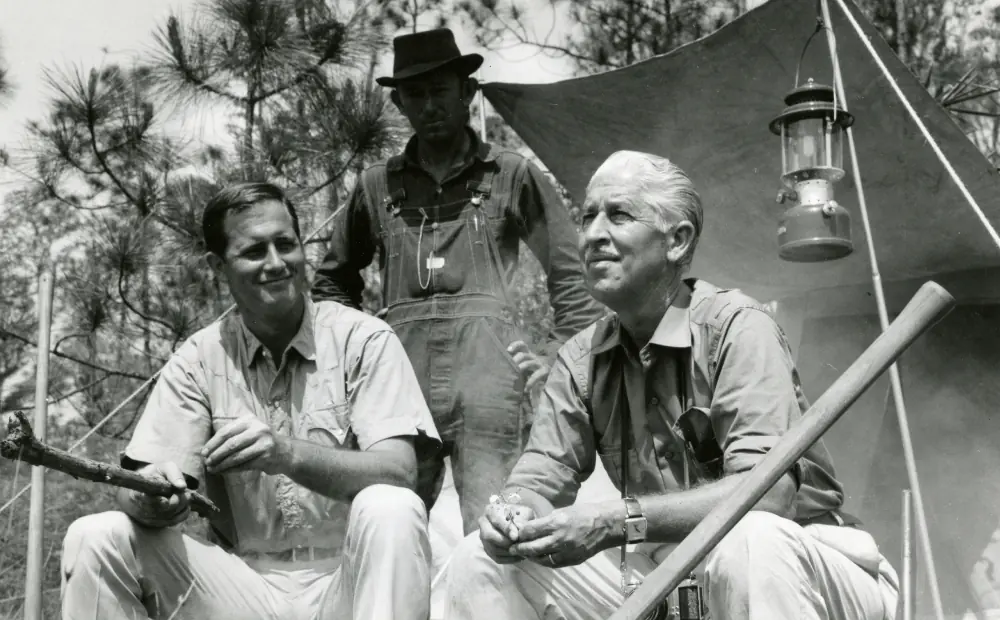0:01
Wild polar bears build up the fat and energy they need by feeding nonstop on ice covered seas.
0:08
I saw this first hand nearly 40 years ago, the last time I was in the Arctic for Wild Kingdom.
0:14
I was lucky enough to take part in a tracking study of polar bears favorite food?
0:19
Blubbery ring seals.
0:21
We've used glue to attach a transmitter that will fall off next summer when the seal molts to study them as an index to the health of their population.
0:29
Any changes could affect the survival of polar bears who depend upon seals for food.
0:35
Hunting ring seals is especially important for female polar bears so they can get fat enough to face the demands of raising cubs.
0:44
You see it?
0:45
Look right here.
0:46
It's a good.
0:46
Oh, my gosh.
0:48
On the outskirts of Churchill, Manitoba, in Canada, Rae and I have just spotted a polar bear mom in her cub with the help of veteran tracker Dennis Comperet.
0:58
Oh, it's bear time.
1:00
It's bear time.
1:00
It's bear time.
1:03
There.
1:03
She's giving up right now.
1:04
Yeah.
1:04
Look, you can see.
1:05
Look, she just she just raised her head.
1:07
I'm so glad the first polar bear I saw was a Mama bear.
1:11
That is just perfect for me.
1:14
See, the main thing about working with bears is a lot of people try to sneak up on them and be sneaky, but you have to let them know you're there right, right off the bat.
1:22
Then they'll, you know if they'll tolerate you or not.
1:24
You know what a startle a bear, that's the worst thing.
1:30
Dennis expertly maneuvers us to higher ground where the landscape unfolds before us.
1:35
So what I'm going to do is I'm going to walk first if you guys stay 3 or 4 steps behind me till I get into a comfortable position, Right?
1:43
And then we'll just stay quiet for a while and see what happens.
1:46
OK.
1:46
OK.
1:49
There she is.
1:50
Right there, right there.
1:54
See the top of her back?
1:55
Yeah, yeah.
2:02
Yeah.
2:06
Yeah.
2:06
Oh my God.
2:06
Oh, that's unbelievable.
2:09
Yeah.
2:10
And look at those two solitary hunters.
2:15
Polar bears typically keep to themselves, except for mothers and their cubs.
2:20
Pregnant females dig snow dens in the fall, where they give birth during the harsh winter months.
2:25
This brave mother emerged from her den last spring, cub by her side while she was Denning.
2:33
This polar bear mom may not have eaten for three months.
2:37
To survive, she gorged herself on seals beforehand, packing on hundreds of pounds to fuel her cup.
2:44
Her milk is 30% fat, just like the heaviest whipping cream.
2:50
Look, the cub is coming down a little bit.
2:52
It's coming off of the rock, away from its mom.
2:55
Little rest.
2:55
Now it's playtime, you know, going to go Snoop around his surroundings, see if kind of mischief he can get into.
3:01
But if he gets out of hand, there'll be just a subtle huff from the moment.
3:05
He'll just fall right back into place and snuggle up again.
3:11
Well guys, we spent some time here.
3:13
I think we should give her some space and back away.
3:15
Let's go.
3:21
This healthy looking mother and cub offer a glimpse of hope.












